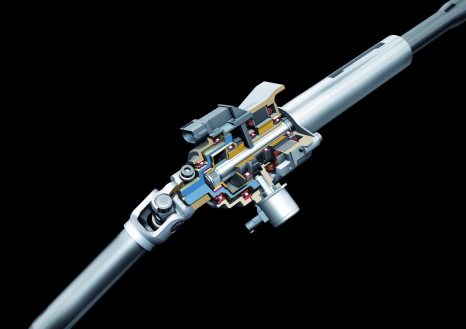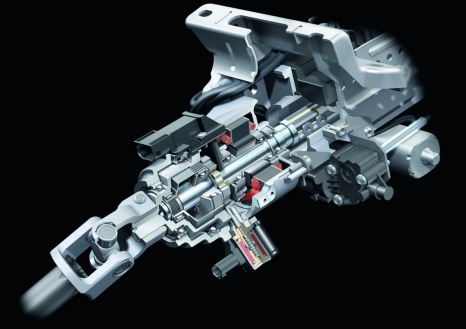Dynamic steering
Audi will include its high-tech dynamic steering on request in some model lines. Dynamic steering varies the steering ratio by nearly 100 percent as a function of driving speed and the setting in the Audi drive select system in which it is integrated. Transitions are continuous and practically imperceptible.
The central component of dynamic steering is a superposition gear integrated into the steering column and driven by an electric motor. The so-called harmonic drive was originally developed for robotics and space flight. The unit is compact, light and torsion-resistant, and reacts free of play, precisely, and with low friction. The harmonic drive can transmit immense amounts of torque extremely quickly and is very efficient.
The harmonic drive transmission has only three main operating components. An electric motor turns an elliptical inner rotor which, by way of a ball bearing, alters the shape of a thin sunwheel connected to the steering input shaft. At the vertical axes of the ellipse, the sunwheel meshes with the teeth of an annulus or ring gear, which acts on the steering output shaft. When the inner rotor is turned, the main axis of the ellipse changes, and with it the extent of gear tooth meshing. Since the sunwheel has fewer teeth than the annulus, there is relative movement between them – the superimposed movement used to alter the effective steering ratio. The wide gear ratio of the electric motor operating at high speed makes it possible to generate this superimposed movement quickly and precisely.
At low vehicle speeds – in city traffic and when maneuvering – dynamic steering is very direct; two turns of the steering wheel is all it takes to go from one lock to the other. The power assist is also high, making it very easy to maneuver the car into a parking space. On interurban roads, the system gradually becomes less direct and provides less power assist. At fast highway speeds, an indirect steering ratio and low level of power assist smooth out choppy movements of the steering wheel to facilitate effortless tracking.
The dynamic steering system cooperates closely with the ESP stabilization program in the sportiness and safety areas. It even countersteers if necessary. In most situations, its subtle interventions, which the driver often does not even notice, result in a load change that reduces understeer or oversteer as required. When braking on surfaces with varying frictional coefficients, the system provides the necessary assistance through stabilizing steering interventions.
The dynamic steering needs less time for its corrections than the brake system needs to develop pressure at the wheels. In many situations it does most of the work and there is no need for the braking maneuvers, or they serve only as damping to reduce speed. This increased driving safety and sportiness are particularly pronounced when driving at higher speeds on a slick substrate such as snow.
Status: 2011

